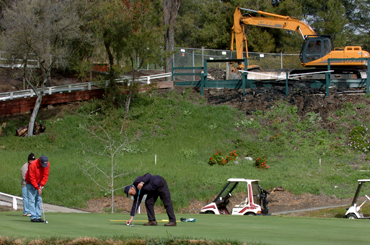
State and golf course board at odds over the future of the
storied course
It’s been a mainstay in San Benito County since the 1920s, and
it also happens to be one of the oldest golf courses in the United
States west of the Mississippi River. Ever since it opened, Bolado
Park Golf Course has been the ideal venue for golfers looking to
play a round on a course that was friendly to all levels of play at
reasonable rates.
State and golf course board at odds over the future of the storied course
It’s been a mainstay in San Benito County since the 1920s, and it also happens to be one of the oldest golf courses in the United States west of the Mississippi River. Ever since it opened, Bolado Park Golf Course has been the ideal venue for golfers looking to play a round on a course that was friendly to all levels of play at reasonable rates.
But now Bolado Park Golf Course’s future is as uncertain as a curling, 10-foot par putt.
The problems began after a fire destroyed its clubhouse in January, resulting in a severe drop off in play, and food and equipment sales revenues. The problems continued last month when the renewal of a long-term lease by the 33rd District Agricultural Association – the state entity from which the club leases the land where the course is situated – was rejected.
With the current lease slated to expire in two years, financial institutions are reluctant to fund any loans to rebuild the clubhouse without assurance that the rental agreement will be extended.
The club’s Board of Directors wants the lease to be extended to 30 years. The state contends that 30-year leases are things of the past, and isn’t concerned with extending the club’s current lease since it has yet to expire.
“We proposed a 30-year lease and a cap on some kind of residual basis – a fixed fee plus the cost of living escalation,” said Bolado Park Golf Club Board Member Treasurer Phil Freeland.
“The state doesn’t do long leases like they’ve done in the past,” said 33rd District Fair Board President Tom Slavich. “They do lease in five-year increments at a time. That’s pretty much how they do them.”
On Tuesday, the Board members from the golf club met with the 33rd District Agricultural Association in a last-ditch effort to get the state-run institution to agree to a long-term extension of its existing rental agreement with the course, but discussions broke down and the situation is still unchanged.
Without any assurance from the district that the lease will ever be extended, club leaders say that they have no incentive to rebuild its clubhouse, and the club’s ability to secure insurance money also will expire if construction of a new clubhouse does not commence within six months from the date of the Jan. 21 fire.
The club has $525,300 of insurance money pending from the Fireman’s Fund to rebuild the structure. But the club’s Board says there is no point in rebuilding without a new lease.
“A lot of people are already willing to volunteer their time and donate to rebuild,” Freeland said. “But they don’t want to go out on a limb if there is no benefit from doing so. They want to know what’s going on. I think there is some other plan in mind there (with the District). I heard that information that a number of nonprosperous fairgrounds need to get rid of some white elephants. We’re concerned that the course could be sold, converted to another use or reverted to the county.”
The state claims that the sole focus should be on rebuilding the structure first.
“I’d like them to move forward on this,” Slavich said. “It would be different if they had no insurance. They should be able to build the clubhouse with their insurance, and the state even has insurance that could pick up the difference. I don’t know why they would need a construction loan because the insurance would be the bank on this.”
Since talks between both sides have broken down in recent weeks, speculation is brewing that more controversial plans for property are in the works.
“It does not look good right now for the course. In all honesty, we don’t know what they (33rd District) is planning,” said Bolado Golf Course General Manager Dan Holt. “The only logical explanation is that District 33 wants to run the course by themselves or bid it out. One part of the course has to remain for recreational uses. That could mean that it could be turned into a driving range, a campground, and a par-3 course or used for miniature golf. The other half could become condos, townhouses or single-family homes, or they could sell it to someone who wants to grow grapes on it. The side they can do that on is the water side anyway. We don’t know what they want to do.”
The state doesn’t agree.
“This type of talk has been going on for 40 or 50 years,” Slavich said. “In the next 50, I’m sure there will be a golf course there. They need to concentrate on building a permanent structure, put together a set of plans and costs estimates and start moving forward. They have insurance on it. And since it’s a state property they don’t need to pull county building permits on it.”
According to historical documentation regarding the property, originally the land that part of the course is located on as well as the land that the adjacent county fair grounds sits on were owned by the Bolado-Davis family.
The property was then willed to the state with provisions that it would always be used for recreational purposes.
Originally the course included just a handful of holes on the fairgrounds side of the property.
In 1950, additional adjacent land was purchased by the state from the Etcheverry family and the course was moved across the street and made into the 9-hole layout that it is today.
Shortly afterwards the course was renamed the San Benito Golf and Country Club before switching back to Bolado Park Golf Club a few years later.
In 1950 the state issued the non-profit club a 25-year lease at $1 a year and extended it another 25 years in 1975.
In 1999, a new lease was negotiated and the club agreed to pay 10 percent of its gross revenue to the state – a figure that averaged between $30,000 and $35,000 annually, and topped out at $42,000 in 1999.
In 2003, terms of that lease were extended another five years.
Shortly after the current lease was signed the course began operating in the red. Over the past four years it has averaged annual loses of $56,500.









